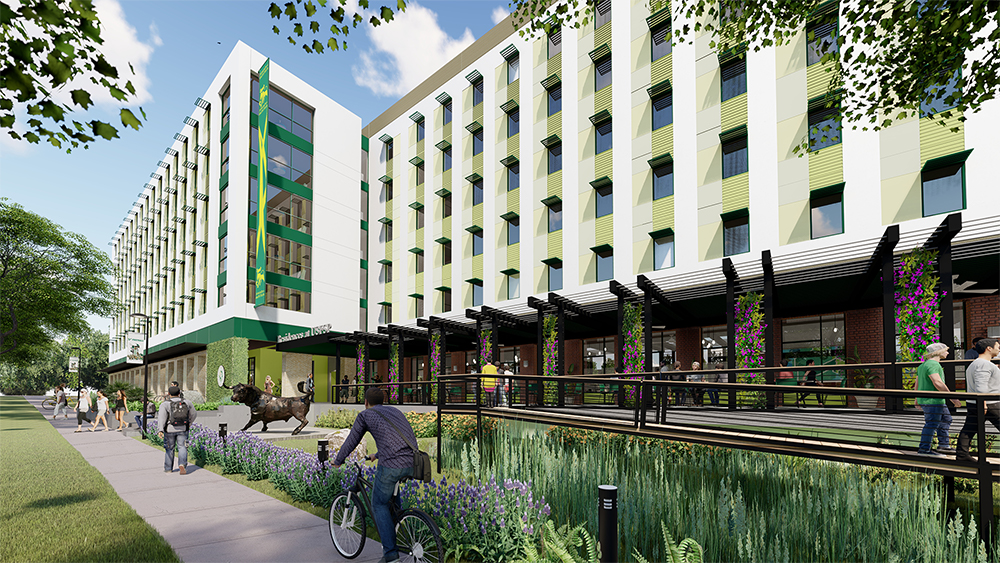
Courtesy of Carrie O’Brion
By Dylan Hart
When the St. Petersburg campus opens its third residence hall in July, it’s possible that some of its rooms will be empty.
As a result, university administration are looking to new strategies — like opening the dorms to graduate students and St. Petersburg College students who hope to transfer to USF St. Petersburg eventually.
The surprising shortage of occupants for the residence hall comes because the number of first-time-in-college freshmen – the group that traditionally fills on-campus housing – has fallen sharply, according to Regional Chancellor Martin Tadlock.
At a USF St. Petersburg Faculty Senate meeting last month, Tadlock said that 340 FTIC freshmen are projected to start at the university in the summer and fall of 2020, a slight uptick from last year’s 319 FTIC freshmen. Tadlock said the number is still expected to “evolve over the next few months.”
The third residence hall, recently dubbed The Osprey, expands the number of on-campus beds from 541 to 916. It will also house the university’s first full-service dining hall.
In years past, an overwhelming majority of students living in the dorms were first-time-in-college freshmen. Data from 2018 detailed that only 18 percent of students lived on campus that year, and 65 percent of those students were FTIC freshmen.
The opening of the third residence hall comes at an awkward time for the St. Petersburg campus.
In December 2015, the USF system Board of Trustees approved a 10-year master plan for St. Petersburg that projected an enrollment of 10,000 students by 2025 and on-campus housing for 950 more students.
When plans for the third residence hall were rolled out in 2016, they called for 550 beds in a 10-story building topped by a conference center.
That all changed in 2018, however. That’s when Pinellas County legislators sprang their surprise move to consolidate the three campuses of USF – which were then separately accredited – into one by July 2020.
The mandate to consolidate jolted the St. Petersburg campus and stalled the momentum to expand.
The campus, which had already started raising its admissions requirements, has now raised them even more, which caused the number of FTIC freshmen entering in fall 2019 to plummet by 52 percent.
Meanwhile, the campus downsized its plans for the third residence hall from 10 stories with 550 beds to six stories with 375 beds.
“This is a historic event for USF St. Petersburg,” Tadlock said in a university news release on the new residence hall’s groundbreaking in April 2019.
“This new residence hall and dining facility will not only provide much-needed affordable living and dining options for our students – it will foster a greater sense of community and help us with our efforts to continue improving student success.”
Tadlock said this was an “expected dip.” As enrollment requirements have risen, incoming FTIC freshmen numbers have dropped. In the face of lowered enrollment and expanded housing on campus, the university is changing its approach toward student housing.
The biggest effort so far in changing that philosophy involves enticing students to return to housing after their first year.
Nicholas Setteducato, the university’s interim regional vice chancellor for administrative and financial services, said that administration wanted to change their approach toward housing availability.
“We want to eliminate that perception (that beds aren’t available) and make it clear that this is available,” Setteducato said.
The smaller number of incoming students is a big shift from a few years ago, when demand was high and the university outsourced extra housing to places like the Hilton St. Petersburg Bayfront hotel and an external apartment complex.
“When I got here four years ago, there was a waitlist of over 125 students for university housing,” Tadlock said. “That’s always been there. Now we can accommodate the waitlist and more.”
USF St. Petersburg is even considering keeping costs the same as when students first entered housing to encourage students to return, but Setteducato said that plan isn’t set in stone.
“The costs go up for housing every year, but one of the things we might think be possible for us to do…is to hold that cost — and not just the cost of the housing, but the cost of the meals as well,” he said. “I’m pretty confident that we’ll be able to offer something.”
Some other unconventional strategies the university is considering include bringing in graduate students and students from St. Petersburg College who intend to transfer to USF St. Petersburg through the PATHe and FUSE programs.
USF’s reciprocal agreements with Latin American countries give students who meet certain requirements in-state tuition, Setteducato said, and the university hopes to “make it desirable for them to live on-campus as opposed to finding alternative housing.”
Additionally, Setteducato hopes to draw in students from around Pinellas County. Students who live in Pinellas County and live in the residence halls are very few despite lengthy commutes, he said.
There are plans in the long term to increase the campus’ parking capacity, Setteducato said.
“In the long term, there has always been a plan that there would be a second phase of our parking garage,” Setteducato said.
For now, however, the plan is to push overflow parking to a green space behind the Poynter Institute on Third Street S.
Despite the possibility of empty residence hall rooms in the fall, Tadlock and Setteducato were eager to push the positive side of the extra space. For one, the university may use the rooms as student offices, Tadlock said.
“It’s always better to be able to open up a $30-million facility on campus that is exclusive for student life,” Setteducato said. “I mean, this is incredible.”
“We anticipated a downturn in enrollment,” Tadlock added. “In a way, it’s kind of a huge positive. It’ll get more crowded again, believe me. And then we’ll have a waitlist.”




One thought on “With a new dorm opening soon, how will USF St. Petersburg fill beds?”